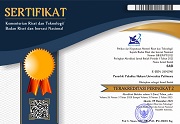Konstruksi Penataan Daerah dan Model Pembagian Urusan Pemerintahan
 )
)
(1) Fakultas Hukum Universitas Pattimura, Ambon, Indonesia
 Corresponding Author
Corresponding Author
Abstract
Keywords
DOI
10.47268/sasi.v26i4.414
Published
2020-12-30
How To Cite
@article{SASI414,
author = {Sherlock Lekipiouw},
title = {Konstruksi Penataan Daerah dan Model Pembagian Urusan Pemerintahan},
journal = {SASI},
volume = {26},
number = {4},
year = {2020},
keywords = {Regional Arrangement; Division Model; Government Affairs.},
abstract = {Regional arrangement and distribution model of governmental affairs. The purpose of this research is to provide clarity regarding the legal interpretation of the formulation of norms in regional government laws. Research methods The research method uses normative research through a conceptual approach and a statue approach. The results showed that the development of decentralization into a state administration system had an impact on local government institutions, one of which was the distribution pattern of government affairs. Thus, comparing the distribution of functions is not possible without the overall decentralized institutional framework developed by a country. From this, a comprehensive framework of decentralization institutions and local government is needed. It also does not rule out the possibility for a region to propose governmental affairs that become its specialty, both on a provincial and regional scale. The concept of division of functions is carried out dynamically, where regions can carry out real government affairs (needed and in accordance with regional capacities). It should be possible for districts / cities to propose governmental affairs that are needed or not needed; who can or cannot be arrested. Decentralization can only work if it is based on a number of preconditions, namely a capable and effective central government. Therefore, it is necessary to review various regulations that are not in line with the principle of broadest autonomy.},
issn = {2614-2961}, pages = {557--570} doi = {10.47268/sasi.v26i4.414},
url = {https://fhukum.unpatti.ac.id/jurnal/sasi/article/view/414}
}
Jurnal
[1] Aritonang, Dinoroy Marganda. (2016). "Pola Distribusi Urusan Pemerintahan Daerah Pasca Berlakunya Undang Undang Nomor 23 Tahun 2014 Tentang Pemerintahan Daerah", Jurnal Legislasi Indonesia, 13 (1): 41-41.
[2] Asgar, Sukitman. (2018). "Analisis Yuridis Pasal 18 UUD Tahun 1945 Junto UU Nomor 23 Tahun 2014 Tentang Pemerintahan Daerah", Jurnal HIBUALAMO, 2 (1): 58-68.
[3] Aridhayandi, M. Rendi. (2018). "Peran Pemerintah Daerah Dalam Pelaksanaan Pemerintahan Yang Baik (Good Governance) Dibidang Pembinan dan Pengawasan Indikasi Geografis", Jurnal Hukum & Pembangunan, 48 (4): 883-902. https://doi.org/10.21143/jhp.vol48.no4.1807
[4] Budiyono.,Muhtadi., Firmansyah, Ade Arif. (2015). "Dekonstruksi Urusan Pemeritahan Konkuren Dalam Undang Undang Pemerintahan Daerah", Kanun: Jurnal Ilmu Hukum, 17 (3): 419-432.
[5] Djambar., Nahar, M Yasin., Tavip, Muhammad. (2017). "Penyelenggaraan Urusan Pemerintahan Bidang Pertambangan Dalam Prespektif Otonomi Daerah", eJurnal Katalogis, 5 (2): 26-35.
[6] Hasrul, Muh., (2017). "Penataan Hubungan Kelembagaan Antara Pemerintah Provinsi dengan Pemerintah Kabupaten/Kota", Perspektif, 22 (1): 1-20. https://doi.org/10.30742/perspektif.v22i1.601
[7] Matitaputty, Merlien I. (2012). "Desentralisasi dan Hubungan Pemerintah Pusat dan Daerah di Indonesia (Problem dan Tantangan)", SASI, 18 (1): 21-28.
[8] Suryanto. (2015). "Urusan Pemerintahan Daerah, Kemungkinan Problematika Implementasi Undang Undang Nomor 23 Tahun 2014", Jurnal Desentralisasi, 13 (2): 133-146. https://doi.org/10.37378/jd.2015.2.133-146
[9] Said, Abdul Rauf Alauddin. (2015), "Pembagian Kewenangan Pemerintahaan Pusat - Pemerintahan Daerah Dalam Otonomi Seluas Luasnya Menurut UUD1945", Fiat Justisia: Jurnal Ilmu Hukum, 9 (4): 577-602. https://doi.org/10.25041/fiatjustisia.v9no4.613
Buku
[10] Andi, Gadjong Agussalim. (2007), Pemerintahan Daerah-Kajian Politik dan Hukum, Jakarta: Ghalia Inodnesia.
[11] Hadjon, Phlipus M et al. (1993). Pengantar Hukum Administrasi Indonesia, Yogyakarta: Gadja Mada University Press.
[12] Hadjon, Philipus M. dan Sridjatmiati, Tatiek. (2005). Argumentasi Hukum, Yogyakarta: Gadja Mada University Press.
[13] Huda, Ni'matul. (2007), Pengawasan Pusat Terhadap Daerah Dalam Penyelenggaraan Pemerintahan Daerah, FH UII Press.
[14] Marzuki, Peter M. (2005). Penelitian Hukum Jakarta: Kencana Prenada Media Group
[15] Strong, C. F. (1960). Modern Political Constitutions an Introduction to the Comparative Study of their History and Existing Form, London: Fith Printed, Sidwick & Jackson Limited.
Lain-Lain
[16] Hadjon, Philipus M. (1997). Pengkajian Ilmu Hukum, Makalah, Pelatihan Metode Penelitian Hukum Normatif, Surabaya: Universitas Airlangga
[17] Hadjon, Philipus M. (2004), Kedudukan Undang-Undang Pemerintahan Daerah Dalam Sistem Pemerintahan, disampaikan dalam Seminar Sistem Pemerintahan Indonesia Pasca Amandemen UUD 1945 diselenggarakan oleh Badan Pembinaan Hukum Nasional Departemen Kehakiman dan Hak Asasi Manusia R.I. Bekerjasama dengan Fakultas Hukum Universitas Airlangga dan Kantor Wilayah Departemen Kehakiman dan Hak Asasi Manusia Provinsi Jawa Timur, Surabaya.
[18] Kertapradja, E. Koswara. (2007). Pokok-pokok Pikiran dalam Permasalahan Kedudukan Gubernur sebagai Wakil Pemerintah Pusat, Makalah dipersiapkan untuk bahan masukan pembahasan Revisi UU No. 32 Tahun 2004, Roundtable Meeting.
[19] Manan, Bagir. (1994). Hubungan Antara Pusat Dan Daerah Menurut UUD 1945, Jakarta: Pustaka Sinar Harapan.
[20] Manan, Bagir. (2004), Menyongsong Fajar Otonomi Daerah, Yogyakarta: Pusat Studi Hukum Faluktas Hukum Universitas Islam Indonesia.
[21] Maksum, Irfan Ridwan. (2009). Perbandingan Sistem Pembagian Urusan Pemerintahan Antara Pemerintah Pusat Dan Daerah Otonom, _Laporan DSF Bank Dunia.
Cited-By:
1. Rekomendasi Badan Pengawas Pemilihan Umum Kepada Komisi Pemilihan Umum Dalam Menangani Pelanggaran Pemilu Pasca Penetapan Hasil Perolehan Suara Secara Nasional
Gilbert Marc Baljanan, Sherlock Halmes Lekipiouw, Yohanes Pattinasarany
Jurnal Saniri vol: 5 issue: 2 first page: 56 year: 2025
Type: Journal [View Source]
2. Rangkap Jabatan Menteri Sebagai Pimpinan Partau Politik Dalam Sistem Ketatanegaraan Di Indonesia
Ibnu Arradzie Panigfat, Jemmy Jefry Pietersz, Garciano Nirahua
Jurnal Saniri vol: 4 issue: 1 first page: 1 year: 2023
Type: Journal [View Source]
| Dublin Core | PKP Metadata Items | Metadata for this Document | |
| 1. | Title | Title of document | Konstruksi Penataan Daerah dan Model Pembagian Urusan Pemerintahan |
| 2. | Creator | Author's name, affiliation, country | Sherlock Halmes Lekipiouw; Fakultas Hukum Universitas Pattimura, Ambon; Indonesia |
| 3. | Subject | Discipline(s) | |
| 3. | Subject | Keyword(s) | Regional Arrangement; Division Model; Government Affairs. |
| 4. | Description | Abstract | Regional arrangement and distribution model of governmental affairs. The purpose of this research is to provide clarity regarding the legal interpretation of the formulation of norms in regional government laws. Research methods The research method uses normative research through a conceptual approach and a statue approach. The results showed that the development of decentralization into a state administration system had an impact on local government institutions, one of which was the distribution pattern of government affairs. Thus, comparing the distribution of functions is not possible without the overall decentralized institutional framework developed by a country. From this, a comprehensive framework of decentralization institutions and local government is needed. It also does not rule out the possibility for a region to propose governmental affairs that become its specialty, both on a provincial and regional scale. The concept of division of functions is carried out dynamically, where regions can carry out real government affairs (needed and in accordance with regional capacities). It should be possible for districts / cities to propose governmental affairs that are needed or not needed; who can or cannot be arrested. Decentralization can only work if it is based on a number of preconditions, namely a capable and effective central government. Therefore, it is necessary to review various regulations that are not in line with the principle of broadest autonomy. |
| 5. | Publisher | Organizing agency, location | Faculty of Law, Universitas Pattimura |
| 6. | Contributor | Sponsor(s) | |
| 7. | Date | (YYYY-MM-DD) | 2020-12-30 |
| 8. | Type | Status & genre | Peer-reviewed Article |
| 8. | Type | Type | |
| 9. | Format | File format | PDF, HTML |
| 10. | Identifier | Uniform Resource Identifier | https://fhukum.unpatti.ac.id/jurnal/sasi/article/view/414 |
| 10. | Identifier | Digital Object Identifier | 10.47268/sasi.v26i4.414 |
| 11. | Source | Title; vol., no. (year) | SASI; Vol 26, No 4 (2020): Volume 26 Nomor 4, Oktober - Desember 2020 |
| 12. | Language | English=en | en |
| 13. | Relation | Supp. Files | |
| 14. | Coverage | Geo-spatial location, chronological period, research sample (gender, age, etc.) | |
| 15. | Rights | Copyright and permissions | Copyright: Authors who publish their manuscripts in this Journal agree to the following conditions: 1. The copyright in each article belongs to the author, as well as the right to patent. 2. Authors can enter into separate, additional contractual arrangements for the non-exclusive distribution of the journal's published version of the work (e.g., post it to an institutional repository or publish it in a book), with an acknowledgment of its initial publication in this journal. 3. Authors are permitted and encouraged to post their work online (e.g., in institutional repositories or on their website) before and during the submission process, as it can lead to productive exchanges, as well as earlier and greater citation of published work. 4. Authors have the right to self-archiving of the article (Author Self-Archiving Policy)
License: The SASI Journal is disseminated based on the Creative Commons Attribution-NonCommercial 4.0 International license terms. This license allows anyone to copy and redistribute this material in any form or format, compose, modify, and make derivatives of this material for any purpose. You cannot use this material for commercial purposes. You must specify an appropriate name, include a link to the license, and certify that any changes have been made. You can do this in a way that is appropriate but does not imply that the licensor supports you or your use.
|
Copyright (c) 2020 Sherlock Halmes Lekipiouw

This work is licensed under a Creative Commons Attribution-NonCommercial 4.0 International License.
Cited-By:
1. Rekomendasi Badan Pengawas Pemilihan Umum Kepada Komisi Pemilihan Umum Dalam Menangani Pelanggaran Pemilu Pasca Penetapan Hasil Perolehan Suara Secara Nasional
Gilbert Marc Baljanan, Sherlock Halmes Lekipiouw, Yohanes Pattinasarany
Jurnal Saniri vol: 5 issue: 2 first page: 56 year: 2025
Type: Journal [View Source]
2. Rangkap Jabatan Menteri Sebagai Pimpinan Partau Politik Dalam Sistem Ketatanegaraan Di Indonesia
Ibnu Arradzie Panigfat, Jemmy Jefry Pietersz, Garciano Nirahua
Jurnal Saniri vol: 4 issue: 1 first page: 1 year: 2023
Type: Journal [View Source]

 : 13085 times
: 13085 times Download : 34700 times
HTML
Download : 34700 times
HTML 















